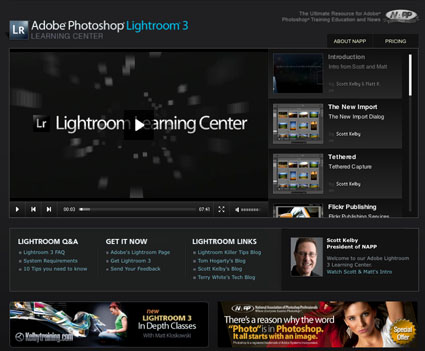Russell Brown – Photoretouching in Camera Raw
Learn more about Photoshop and Lightroom in my DVDs and Workshops.
Learn more about Photoshop and Lightroom in my DVDs and Workshops.
Learn more about Photoshop and Lightroom in my DVDs and Workshops.
Learn more about Photoshop and Lightroom in my DVDs and Workshops.
Learn more about Photoshop and Lightroom in my DVDs and Workshops.
Julieanne Kost provides 10 in-depth tutorials on Lightroom 3.
What’s New In Lightroom 3
Be Organized
Select, Rate, and Prioritize Your Images
Lens Correction & Perspective Correction
Create Stunning Images
Converting Images to Black and White
Moving Between Lightroom and Photoshop
Publish A Slideshow
Print the Perfect Image
Share Images on the Web
View them on Adobe TV.

NAPP’s Adobe Photoshop Lightroom 3 Learning Center has been updated.
New content highlights the latest features in the version shipping now.
Whether you’re using Lightroom for the first time or simply upgrading, this fabulous resource will help you make the transition smoothly.
Free online videos include …
1 The New Import
2 Tethered Shooting
3 Flickr Publishing
4 Watermarking
5 Better Noise Reduction
6 Lens Correction
7 Improved Vignettes
8 New Process Version
9 Overall Develop
10 New Grain Effect
11 Slideshow Improvements
Plus you’ll find lots of links to other great resources.
Visit NAPP’s Adobe Photoshop Lightroom 3 Learning Center here.

Adobe announced Lightroom 3 today !
It’s a major upgrade. If you’re using Lightroom 2 don’t even think about not upgrading. If you’re not using Lightroom, think about it – seriously.
The shipping version has new features not available in the public beta version. (Automated Lens Correction is the big one.)
Price $299 new / $99 upgrade.
Learn more in a free webinar by Julianne Kost – Thursday, July 15, 2010 10:00 am PDT. Professional Photographer Workflow – Adobe Photoshop CS5 and Adobe Photoshop Lightroom.
Learn more at Adobe.com here.
Read Adobe’s press release here … Read More
Interesting use of the new CS5 blend modes Divide and Subtract.
How can you use them for your images?
Using a Wacom stylus makes Photoshop CS5’s new brushes feel even better.
Russell Brown shares his insights on his top 5 Photoshop CS5 features.
Everyday this week at 1:30 and 4 pm EST view the free live CS5 webinars at NAPP.
Thursday, April 15 12 – 1 pm PDT, Julianne Kost and Bryan O’Neil Hughes will hold a live Q&A session on Twitter. Tweet your questions to @Photoshop and use the hashtag #AskAPro.